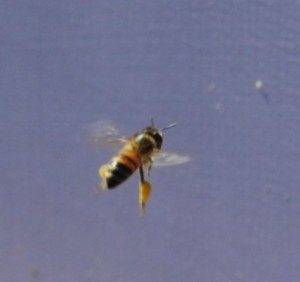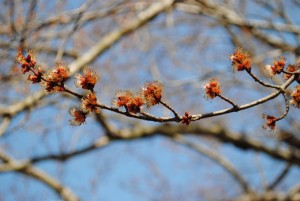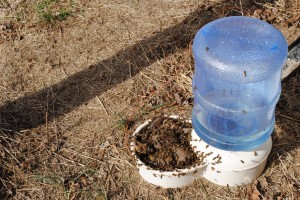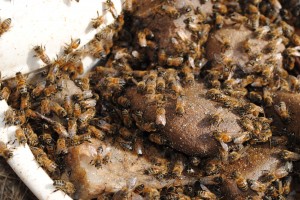Always Start with Two
The weather around Richmond, Virginia continues to be outstanding. It actually hit 84 degrees today, breaking the previous record from back in the 1920’s. Dandilions are in full bloom, as are pears, peaches, plums and apricots. A friend down near Shirley Plantation indicated that her bees were covering the flowering quince in her neighbor’s yard. Basically, there’s a lot of forage out there (even though the official start to my flow, the tulip poplar bloom, has not happened yet.) My findings in the hive inspections for today only confirmed this – as well as reminding me that it’s a daggone good thing that I started my beekeeping with two hives in the Spring of 2009, and not one.
The general tone of today’s inspections included more hives with just a few capped drone cells (but nothing walking about) and more hives with dozens (if not scores) of capped drone brood and many walking about on the comb. The bottom line is that the hives are building up at different rates. I am a big fan of this early build up. I had one hive today (the Westover Hive) with 6 frames (back and front) of brood in the top medium AND 7 frames (not all were back and front) of brood in the bottom deep. It was nothing short of amazing, compared to my other hives (including my other strong ones.) The amount of bees about to come out of this hive is going to be like a volcano. I found the queen and cannot be sure if this is the same queen from last year’s swarm catch, but it doesn’t really matter. These bees are what I want.
- They come from stock that made it through at least 1 Winter before I caught them
- They have made it through one year with me, without a lick of medication or even a powdered sugar dusting.
- They seemed lethargic during brief forays into the 50’s during the Winter (I hope this means they are frugal)
- They build up fast in the Spring
There are other traits that I would like to have, but these are the primary traits that I am looking for at this time of year. I will take at least one Nuc off of them (I’ll probably swipe the old queen (Nuc 1) and a frame of eggs (Nuc 2)). I’ll need to get this done by next weekend – the congestion in that hive is about to go through the roof. I should put up a swarm trap down there this weekend.
The hive beside it (the one that showed more activity in January) is good ole Albo. When I walked up to it, I honestly thought it was my first hive casualty for the year. But, as I unceremoniously removed the inner cover with a loud snap, the tell tale hum of bees could be heard. They are small – maybe at 2 frames of brood with no drones at all – but they are alive. No doubt they will build up and once again fail to provide honey or enough bees for an increase. Albo was one of the first two hives that I started with in 2009. It’s sister hive, Geronimo, has continued to do exceptionally well, whereas Albo just barely survives a Winter (I actually fed them through last Winter, before I adopted my ‘James Bond’ strategy.)
Thank the lord for Geronimo. If I had started with only Albo, who knows what I would be up to today. One thing is for certain, I will be removing that queen this year. As of right now, this is the only hive that I will be requeening this year. They have enough genetic fortitude to make it through the Winter (which is enough for me to let them raise drones for the time being, if they want), but that’s it. I will be using the brood in this hive to fortify my Nuc’s and Queen-breeding boxes, as well as bait for my swarms and/or trap-outs. But, this bloodline will not be with me this Fall.
The final note about my inspections today centers around both the Westover and Berkeley Hives. Both have basically filled up the combs above them and were building honey comb between my inner cover and the top frames (I had not inverted the inner cover yet this year.) Westover had a bunch of comb because I had put a spacer in them to feed them pollen (something I am unlikely to do in the future, but that is a different topic for another day.) So, I have put supers on several hives today, all with some bare foundation to increase my wax stores. The way things are looking today, I would say we could have a real killer of a honey build this Spring (and I still have not purchased an extractor!)
There is an article one of the bee magazines this month about a French beekeeper that stopped medicating a few years ago. He suffered big losses the first few years, but his losses have dwindled substantially now that he has weeded out the chaff (letting those poor hives die off, along with their genetics.) He is actually looking to buy varroa mites, do he can subject his hives to them (and thus weed out more of the weak ones!) I’m not in the market for any varroa, but his experiences over the past couple of years simply cement my resolve to keep up the current plan.
It is clear to me at this point that I have 3 hives that are readying to swarm – and it could happen anytime in the next couple of weeks. I am seriously considering taking two Nucs off of each of those hives (one being the old Queen and one being a frame of eggs.) With my winter Nucs, I honestly have no idea what I would do with 6 more Nucs (plus, my goal was to only start 4). I might just do a simple split with one of these strong hives. We shall see. But, it’s time to go finish work on the last of my swarm traps. These things need to all be up by the end of the weekend for sure.











